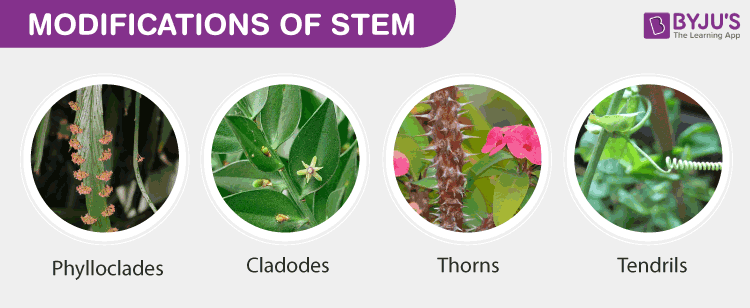The stem helps in providing structure and support to the plant. It is modified into three important types:
-
Underground Modification of Stem
-
Sub-aerial Modification of Stem
-
Aerial Modification of Stem

Underground Modifications of Stem
Some underground stems are modified for food storage and to survive under unfavourable conditions. Some underground stem modifications are:
Rhizome
These are non-green with distinct nodes and internodes. There are auxiliary as well as apical buds. These are brownish in colour. The common types of rhizomes are fleshy due to the storage of food material. It also contains terminal buds. E.g., ginger
The rhizome rootstock grows vertically upwards instead of horizontal. Banana and Alocasia indica are some examples of the rhizome.
Bulb
Many fleshy scale leaves are present. The base of the bulb consists of a cluster of adventitious roots. E.g., onion, garlic.
The bulb may be tunicated or scaley. A sheath of dry membranous scale leaves covers the tunicated bulb. A scaley bulb contains no tunic.
Corm
This condensed form of the stem grows in the vertical direction. It is spherical in shape with a flattened base. It has distinct nodes and internodes. Adventitious roots are present either at the base or all over the body. The auxiliary buds are present on the sides. E.g., Colocasia.
Tuber
It is a fleshy part of the plant which stores food. Potato is the most common tuber largely used as food. The lower part of the potato gets covered by the earth where the adventitious branches grow. It is covered with a number of depressions called “eye” and each eye represents a node. It does not contain adventitious roots. These are largely used as food and grow very slowly.
Sub-aerial Modifications of Stem
In these kinds of plants, the stem is partly above the ground and partly below the ground. These are modified into:
Runner
It is a creeper that runs horizontally on the surface of the soil. The nodes have scale leaves, adventitious roots, and auxiliary buds. Runners arise from the auxiliary buds.
A large number of runners are produced by a mother runner in all the directions. Runners break off and grow into an independent plant giving rise to vegetative propagation. E.g., C-Cynodon.
An underground runner is known as sobole.
Sucker
It arises from the basal part of the main stem. Before separating from the original plant, it develops adventitious roots and leafy shoots. It moves horizontally under the soil for a distance and then grows obliquely upwards. E.g., Mentha
Stolon
These grow aerially for some time and then bend downwards to touch the ground. Here, the terminal bud gives rise to a new stem and adventitious roots. Stolon arises from the base of the main stem. E.g., Jasmine
In horticulture, branches are lowered down to meet the soil where they strike the root. Such natural stolons are found in Mentha spicata.
Offset
It is shorter and thicker and is found in aquatic plants. It originates from the axis of the leaf and grows horizontally. E.g., Pistia. The leaves are produced above and the adventitious roots below. It is a short runner with one internode in length.
Aerial Modifications of Stem
The stems are modified into aerial forms to perform important functions such as climbing, food storage, vegetative propagation, and protection. The stem modifications are as follows:
Stem Tendrils
The stem gets modified into a threadlike leafless structure called tendrils. These are meant for climbing. These may not necessarily contain a branch. Stem tendrils may be:
Axillary: E.g., Passiflora
Extra-axillary: E.g., Luffa
Apical bud: E.g., Grapevine
Floral Bud: E.g., Antigonon
Thorns
These are pointed, hard structures which may or may not bear leaves, branches and flowers. The terminal bud gets modified into thorns. Thorns are used as defence organs and help to check transpiration. E.g., Bouganvillea
Thorns can be distinguished from spines and prickles as they are deep-seated with vascular connections. Prickles are superficial outgrowths on the plant. Spines are the modified plant organs.
Phylloclades
These are leaves modified into scales or spines to check transpiration. This is done by controlling the growth of the leaves. These are fleshy, green, and take part in photosynthesis. This modification is seen in xerophytic plants and stores water. E.g., Opuntia. It consists of fleshy internodes and the leaves are modified into spines or small scaly leaves.
Cladodes
It is a type of phylloclade which consists of only one internode. These are cylindrical but non-fleshy. These help in photosynthesis. Eg., Asparagus. In this, the leaves are modified into prickles.
Bulbils
These are modified axillary vegetative or floral buds meant for food storage. They undergo vegetative propagation to form a new plant. E.g., Dioscorea. In this, the bulbils are condensed auxiliary buds.
Thalamus
It is the axis of the flower and contains the flower organs such as calyx, corolla, androecium, and gynoecium. Silene exhibits clear nodes and internodes.
Thus we see how the stem is modified according to the functions it performs.
For more information, keep visiting BYJU’S website or download BYJU’S app for further reference.
Related Links:-
| Leaves | Shoot System |
| Plant Hormones | Transpiration |

Good, useful for me